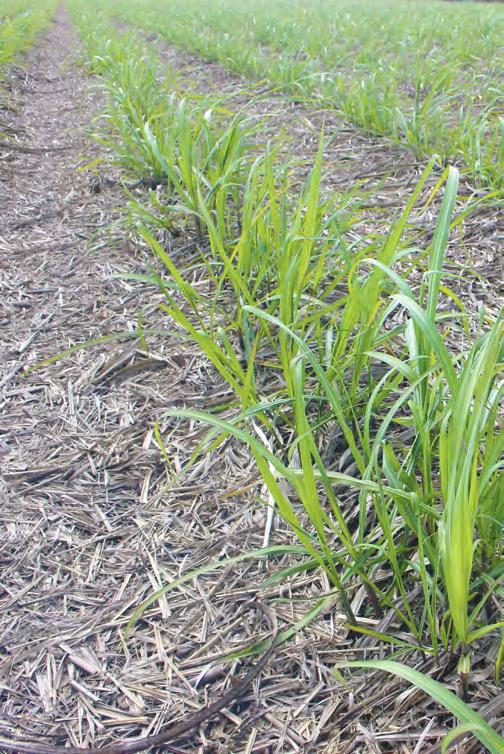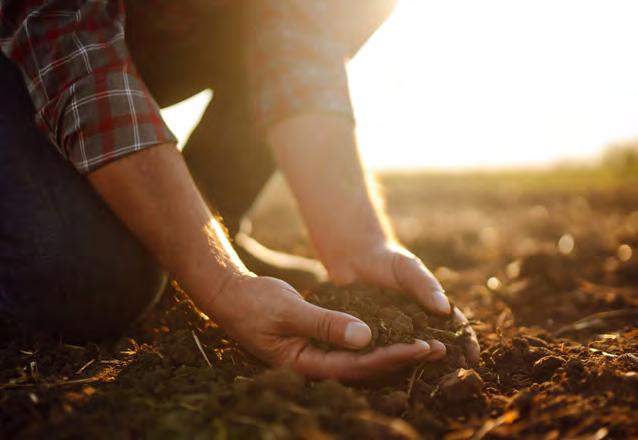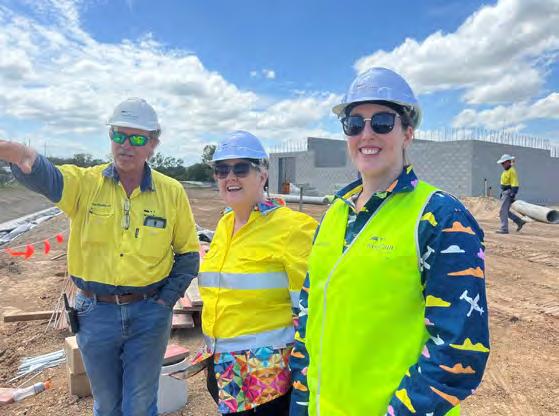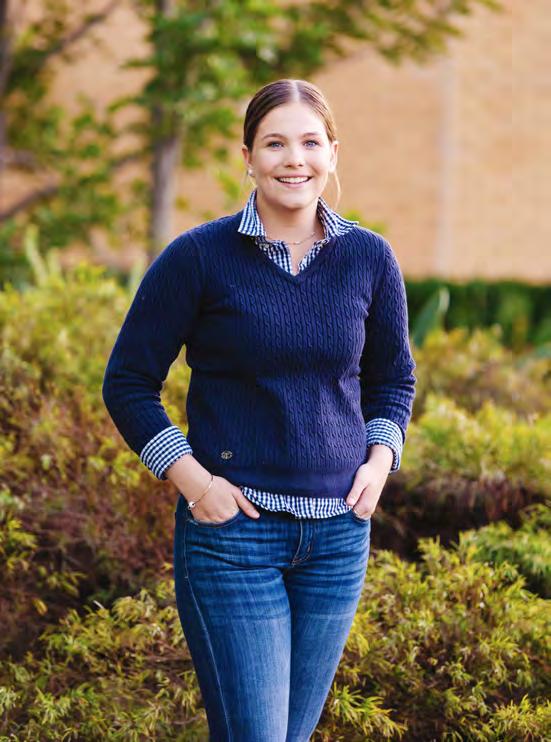
8 minute read
Rural Life 14
from Mackay Life
By Kevin Borg, Chairman, CANEGROWERS Mackay
Young cane with cane trash blanket, helps reduce run-off and build soil health by retaining moisture and delivering organic matter Pictures: Contributed
Advertisement
A National Soil Data Solution
Australia’s national science agency, CSIRO, has revealed details of a $15 million project to develop a national soil information system, aimed at improving the sustainable management of one of the nation’s most precious assets. Supporting the National Soil Strategy, and funded by the Australian Government’s Department of Agriculture, Fisheries and Forestry, the Australian National Soil Information System (ANSIS) project is a collaboration between government, research organisations, industry, the private sector, and the community. Using innovative processes and technologies, ANSIS will allow improved sharing of nationally consistent soil data and information through online access for users.
This will help Australians to better understand our diverse range of soils and make better decisions about managing our important soil resources.
Currently, soil data is collected using different methods, by different organisations, and at a range of depths in the soil. This makes it hard to access, compare and use data from different sources.
ANSIS project lead at CSIRO, Peter Wilson said improving access to the best soil data and information can help promote digital agriculture innovation and is key to sustainably managing Australia’s soils. “By using ANSIS, farmers and agricultural advisors will have access to more soil data and be better placed to more sustainably manage the soil on which they rely.” “Soil is vital to our agricultural production and natural environments, as well as our health and wellbeing. This information system will help us all care for this important natural resource,” Mr Wilson said. “Productive, healthy and resilient soil means more economic, environmental and social benefits to Australia. Monitoring soil also helps our scientific understanding about how our natural world is changing. “This work gives us insights into biodiversity, water resources, landscapes and coastlines, fauna, climate and geology. By harmonising Australia’s soil data, we can make it accessible across many fields of science and exploration.” The new ANSIS system will be available for use in 2023.

WEEKLY PRODUCTION FIGURES
Wilmar Sugar Plane Creek Mill Week 25, Week ending 03 December 2022
This week Season to date
Weekly production figures
Cane crushed 21,061 Average bin weight 3.77 CCS 11.42
1,275,145Wilmar Sugar 3.85Plane Creek Mill Week 22, Week ending 12 November 2022
13.07 This week Season to date Cane crushed 54,157 1,146,725 Cane variety performance for region Average bin weight CCS 3.80 13.01 3.86 13.14
Variety % CCS Variety % CCS Cane variety performance for region Variety % CCS Variety % CCS
Q183 28.9 12.99 Q242 Q183 Q240 6.826.0 24.6 13.23 12.98 13.30Q242 SRA9 3.7 3.3 12.47 12.57 Q208 22.3 13.39 KQ228 Q208 Q253 5.6 17.9 9.9 13.13 12.52 14.12Q138 Q252 3.0 2.7 12.11 13.36
Q240 11.8 13.42 Q138 5.3Comments: 12.17
Q253 9.5 13.05 Q250 2.1 14.14Plane Creek Mill crushed just over 54,000 tonnes of cane for the week, bringing the season total to more than 1,146,000 tonnes. Total mill throughput was below budget due to a number of stoppages throughout the week. The planned 15-hour cleaning intermission on Thursday was extended by seven hours when a replacement injection water pump failed upon restart. Further unplanned stops during the latter part of the week also affected overall throughput. Average weekly CCS was 13.01, down slightly from 13.04 the previous week. The season to date CCS closed out at 13.14 units. The highest CCS was 15.6 units from a rake of Q240 2nd ratoon from the Carmila productivity district. Please continue to use your train brain and remain alert around our cane rail network. Do not linger near any part of the rail network, and only cross the line using designated crossings. Remember our locos are towing heavy loads and can take up to 1km to come to a complete stop. Our cane trains are in operation around the clock, seven days a week during the crushing season.
Comments:
Plane Creek Mill crushed just over 21,000 tonnes of cane for the week, bringing the seasonto-date total to more than 1.2M tonnes. Crushing resumed on Sunday evening following an extended stop to repair the No.3 boiler grate. Heavy rain across the supply district on Tuesday night brought harvesting operations to a halt for the remainder of the week. The highest CCS was 14.25 units from a rake of Q208 5th Ratoon from the Koumala productivity district. With the crushing season extending into the school holiday period, we ask parents and caregivers to talk to children about the dangers of playing on or around our cane rail network. Do not linger near any part of the rail network, and only cross the line using designated crossings. Remember our locos are towing heavy loads and can take up to 1km to come to a complete stop. Our cane trains are in operation around the clock, seven days a week during the crushing season, including over the holiday period.
Jim Kirchner Cane Supply Manager Plane Creek Region

Construction Ramps Up On New Sarina Hospital


FAST FACTS
• Construction on the $31.5m
Sarina Hospital commenced in
February 2022 • It will be located on a flat site in Brewer’s Road and feature an improved layout with capacity for 19 beds • The new hospital will provide enhanced facilities and is expected to be completed mid to late 2023
Woollam Constructions site manager Tony Paull, director of nursing Pauline Maude, nurse unit manager Tammi O'Shea Construction is well underway at Sarina’s new hospital. Photos supplied: MHHS
Sarina-born and bred student Sarah Hamblin has just completed her first year of the AgriFutures Horizon Scholarship program
Sarina residents may have noticed changes to the skyline along Brewer’s Road as work on the new $31.5 million Sarina Hospital picks up pace. Executive Director Public Health and Rural Services Terry Johnson said that despite some earlier delays due to weather, the project was progressing well. “We are all very excited about the construction of our new purpose-built hospital which will equip the Sarina community with a modern facility providing greater capacity and better facilities for all patients, as well as enhanced services including allied health and rehabilitation, all on a more accessible flat site,” Ms Johnson said. “We can now see initial civil works have been completed, and building frames and walls are going up. “We expect to see the site transforming weekly now as we progress towards completion.” The hospital’s director of nursing Pauline Maude and nurse unit manager Tammi O’Shea toured the construction site recently to look at progress. “It’s a hive of activity on site and it was really exciting to see how much progress is being made on the construction of our new hospital,” Ms Maude said. “The frame of the main hospital building is up, and block construction is well underway for the office, kitchen and engineering blocks. “Additional drainage systems have also been installed.” The new Sarina Hospital will have capacity for 19 beds. An improved design will also increase bed occupancy enabling more people to receive care in their own community. Other features include larger consultation rooms in emergency and outpatients, and a purpose-built rehabilitation facility including a larger gym space. The new hospital is expected to be completed in mid to late 2023.
Ag Scholarship Applications Open
Applications are now open for scholarships available to those passionate about the future of Australian rural industries and Sarina-born and bred student Sarah Hamblin can’t recommend the program highly enough. Sarah grew up on a wagyu cattle property 30 minutes west of Sarina and attended Sarina State High School. “I was home every night on the property and I loved it,” Sarah said. “I got to be home with the horses and the cows and all that fun stuff.”
When Sarah finished high school, she opted to take a gap year, working as a station hand on a cattle property. “I guess I always knew I had a passion for ag growing up on a property…but I didn’t really know how many opportunities there were in the industry, so I just took a gap year,” she said. “I absolutely loved it; I learnt so much in that year and I think that’s when I realised I really did want a career in ag.” Sarah undertook a dual degree at the University of Queensland in Gatton, studying Bachelors of AgriBusiness and Animal Science, with the long-term hope to work on a property. “I just want to keep expanding my knowledge in different areas,” she said. “It’s such a diverse industry, especially now with growing food demands, technology, there’s just so many cool avenues you can go down. “I’d definitely love to travel, and I think with ag we’re very lucky that there’s a lot of opportunity to do that.” As Sarah was entering the final two years of her degree, she was made aware of the AgriFutures Horizon Scholarship, an initiative providing eligible university students with a $10,000 bursary over two years. The program provides students with opportunities to develop their leadership skills, expand their networks, attend an annual four-day professional development workshop and complete two weeks of industry work placements per year. The Horizon Scholarship Program is open to students studying agriculture-related or STEM degrees with major studies and/or subject selections that align to agriculture. “Our cohorts are no longer made up solely of ag students from traditional farming backgrounds,” said AgriFutures Australia Managing Director John Harvey “We now have scholars studying engineering, law, business and communications.
“We have scholars from the inner city in the same room as students from cattle stations in central Queensland, and this diversity in backgrounds and thinking is beginning to elevate the conversations beyond anything we’ve seen before.”
Sarah has just completed her third year of study and her first in the program and said it has grown her networks, given her countless more opportunities in the industry and developed her skills personally and professionally. “I think the program, in that way, is unlike anything I’ve ever done before,” she said. “I would just encourage anyone to go out and apply for all of these sorts of things and take every opportunity that comes your way because your network is the biggest thing. “No matter what your interest is, whether you come from an ag background or not, there’s a role in ag that needs all of those different areas.”






